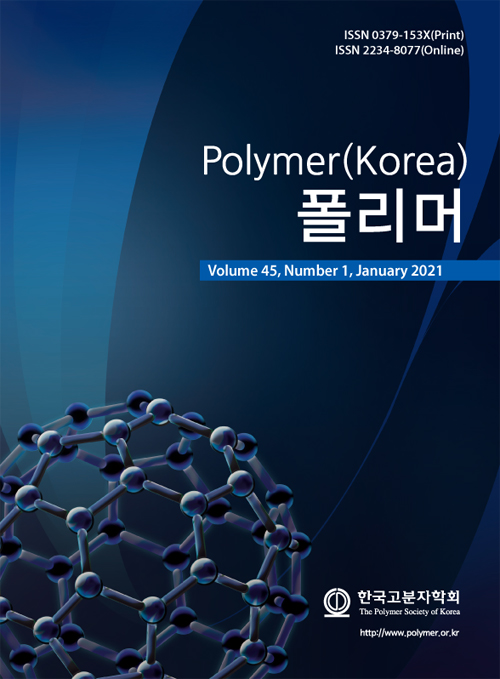- Comparing Waste Gypsum with CaCO3 as Filler Towards Developing Low-cost PBAT Composites
Tae Woong Kong*, **,# , In Tae Kim*,# , Junho Moon*, Tridib Kumar Sinha*, Dong Ho Kim**, Inseon Kim***, Kwangyong Na***, Kyum Woo Choi****, and Jeong Seok Oh*,†

*Department of Materials Engineering and Convergence Technology, ERI, Gyeongsang National University, 501 Jinju-daero, Jinju 52828, Korea
**Space-Aeronautics & Advanced Non-Metal Material Center, Jeonnam Technopark, 1448-345 Goheungman-ro, Goheung 59532, Korea
***Namhae chemical corp., 1384 Yeosusandan-ro, Yeosu-si 59618, Korea
****JS TECH Co., Ltd, Sacheon Industrial Complex, 158 Oegukgieop-ro, Sanam-Myun, Sacheon 52530, Korea- 저비용 PBAT 복합체 제조를 위한 폐석고와 탄산칼슘 충전제 비교 연구
공태웅*, **,# · 김인태*,# · 문준호* · Tridib Kumar Sinha* · 김동호** · 김인선*** · 나광용*** · 최겸우**** · 오정석*,†

*경상대학교 나노신소재융합공학과, **전남테크노파크 우주항공 첨단소재센터, ***남해화학, ****제이에스테크
Melt-mixed composites of poly(butylene adipate-co-terephthalate) (PBAT) with the waste gypsum and calcium carbonate were prepared and their properties were compared. Calcium carbonate and gypsum contain the same cation (Ca2+) but different anions i.e., smaller CO32- and larger SO42- respectively. According to the Fajans’ rule, CaCO3 is more ionic whereas gypsum is more polarizable. Because of the abundant polarizability, gypsum was well dispersed in the PBAT matrix through the filler-matrix electrostatic interaction. The gypsum/PBAT showed lower tensile strength but higher elongation at break at a filler to matrix ratio of 20: 80 than those of CaCO3/PBAT. Further, the addition of polylactic acid (PLA) enhanced both the tensile strength and elongation at break of the gypsum/PLA/PBAT while no such effective changes were observed for CaCO3/PLA/PBAT maybe due to the possibility of depolymerization of polymers in the presence CaCO3. Thermal, morphological, and crystallography studies well corroborate with the mechanical behavior of the composites.
폐석고(CaSO4) 및 탄산칼슘(CaCO3)을 이용하여 poly(butylene adipate-co-terephthalate)(PBAT) 복합체를 용융 혼합으로 제조한 뒤 비교하였다. 석고와 탄산칼슘은 Ca2+ 양이온을 동일하게 포함하지만 다른 크기의 음이온 즉, 각각 SO42-, CO32-을 함유하고 있다. Fajans’ rule에 따르면 CaCO3는 이온성이 더 큰 반면, CaSO4는 편극성이 더 크다. 석고는 탄산칼슘에 비해 편극성이 크기 때문에 filler-matrix간 정전기적 상호작용에 의해 PBAT 내에 분산이 더 잘 되었다. 석고/PBAT 복합체는 충전제-고분자 함량 20:80의 비율에서 탄산칼슘/PBAT 복합체 대비 낮은 인장강도와 높은 연신율 값을 나타냈다. Polylactic acid(PLA)를 첨가함에 따라 석고/PLA/PBAT 복합체는 인장강도와 연신율이 향상했지만 탄산칼슘/PLA/PBAT 복합체의 경우에는 PLA의 첨가에 따른 효과가 관찰되지 않았다. 이는 탄산칼슘에 의한 PLA의 depolymerization에 기인하는 것으로 사료된다. 이러한 복합체의 기계적 거동은 열적, 형태학적, 결정학적 분석을 통해 잘 설명되었다.
Keywords: poly(butylene adipate-co-terephthalate), polylactic acid, gypsum, recycling, melt-mixing
- Polymer(Korea) 폴리머
- Frequency : Bimonthly(odd)
ISSN 0379-153X(Print)
ISSN 2234-8077(Online)
Abbr. Polym. Korea - 2023 Impact Factor : 0.4
- Indexed in SCIE
 This Article
This Article
-
2021; 45(1): 119-128
Published online Jan 25, 2021
- 10.7317/pk.2021.45.1.119
- Received on Aug 31, 2020
- Revised on Oct 13, 2020
- Accepted on Oct 13, 2020
 Correspondence to
Correspondence to
- Jeong Seok Oh
-
Department of Materials Engineering and Convergence Technology, ERI, Gyeongsang National University, 501 Jinju-daero, Jinju 52828, Korea
- E-mail: ohjs@gnu.ac.kr









 Copyright(c) The Polymer Society of Korea. All right reserved.
Copyright(c) The Polymer Society of Korea. All right reserved.